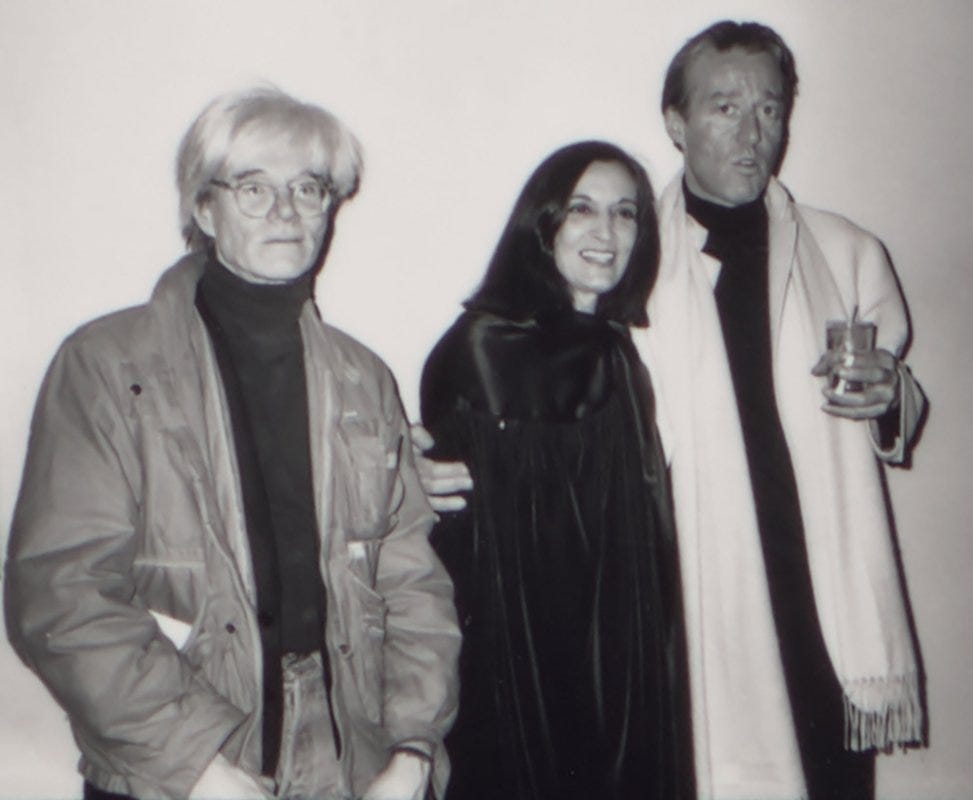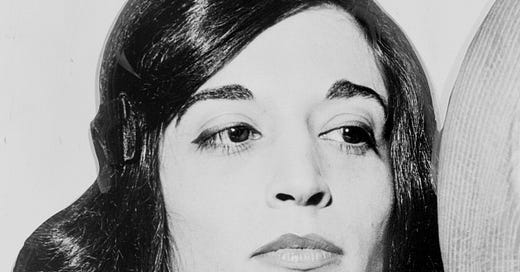What could be a more impossible question than, “Who is your favorite artist?” I must confess, that while I once found this to be an impossible question, there is a name that always springs to my mind straight away. This shouldn’t be a surprise to anyone. She’s literally my profile picture. I share things about her time and again. I buy obscure books on her. For some strange reason, I never wrote about her here.
Anyway, Marisol is the answer. Always and forever.
There can be no question that Marisol’s work is confronting and critical, allowing us to question society and gender norms of the 20th century and those still prevalent today. We cannot ignore the deeper meaning of Marisol’s work or the fact that Marisol made her life into a work of art.
Marisol is in many ways the quintessential archetype of the artist. Outside of perhaps the ‘starving artist’ persona (she was financially stable and thereby able to pursue art full time in a way many others couldn’t), she was the living embodiment of the artist. Where Warhol (a close friend of Marisol’s) was obsessed with the concept of image and persona, Marisol was her persona. In some ways, she is ahead of Warhol and antithetical to him. Warhol was a performer, andMarisol was the living script.

I don’t mean this to be a criticism of Warhol. On the contrary, I think Andy Warhol betrays many of us and was far ahead of his time, creating a ‘brand’ that has rippled into our modern social media world. Even I am guilty of the very things Warhol did, creating a ‘brand’ on Substack to create an image where I can control much of the narrative surrounding me. I can prevent vulnerability in the same way Warhol dismissed the concept of death and spoke of his dead mother as, “shopping in Bloomingdales.”
And that takes us back to Marisol. To understand Marisol one must understand the deeper artist and the absolute funny girl. There’s a famous story of Marisol showing up to an event in a mask.
“On one memorable occasion, [Marisol] came to the Club wearing a mask. Someone called out, ‘Take it off!’ and soon the entire gathering began to chant ‘Take it off!’ Finally acquiescing, she silently removed the mask to reveal a second mask underneath it. ‘Shock and uncontrollable laughter’ followed, according to Irving Sandler, who witnessed the unveiling.” - Ninth Street Women by Mary Gabriel
When this story is spoken of, it’s treated as the prophesying of Pop Art, or to show us how deep and incredible the avant-garde high-brow (I hate that phrase) artist is. I disagree. It’s just really really funny. She’s being funny. She’s making fun of everyone. And everyone’s falling into it.
That story is by no means the only instance in which Marisol’s humor is put into full force, but why is this aspect largely neglected in discussion of her work? Marisol is far from being the first artist to use humor. You’re telling me that drawing a mustache on the Mona Lisa and using a urinal as art isn’t a wee bit funny? Rene Magritte (another personal favorite) was a master of humor. He often used humor in his work, and sometimes that humor gets twisted into deep pseudo-intellectualism that was never his intention. Magritte’s actual personality was no different than the Tumblr fan artist gushing over their fandom and drawing fan art.
There are two reasons for this: one directly influenced by Marisol and one that’s a broader issue. I’ll start with the latter, which is our natural resistance to viewing art under the lens of humor. This isn’t for any bad reason, though I’m sure one could make it sound that way. It would be disrespectful to many artists to view their works as a humorous joke. This is still done, like SNL having two separate parodies about Michelangelo’s Statue of David, but we understand that these jokes are simply jokes. They’re not a studied approach to the most famous sculpture in history. (and do yourself a favor and watch them. Very funny. Wildly inaccurate.)
There are plenty of funny stories in art history to corroborate that humor is in fact a common facet of many artist’s work (see: Michelangelo’s entire career of making art out of spite). But to view an artist’s work shown in museums and galleries as intentionally funny is a dangerous line. Are we laughing with the artist, or at the artist? Are we in on the joke, or are we the joke? Are we respectfully understanding the artist’s intent, or missing it entirely? It’s a slippery slope.
In the case of Marisol herself, the image we have of her as the living embodiment of the artist seems entirely contradictory to the idea of her making art intended as funny. That it’s true is undeniable as far as I’m concerned, but it’s easy to see how our view of Marisol seems to contradict this.
Marisol Escobar was born May 22, 1930, in Paris, France as the daughter of Venezuelan parents. While she grew up in the United States and Venezuela, it’s often a source of confusion about how to label her. Personally, I find it annoying when anyone calls her a French or Parisian artist when Venezuelan is more accurate. But I digress. The big turning point in Marisol’s life, when she went from Marisol Escobar to Marisol, was the death of her mother when she was eleven. What followed was the making of an artist.
She spent the years after her mother’s death, believed to be a suicide which did not sit well with her Catholic upbringing, in complete silence. It’s said that Marisol didn’t speak until she was 14 years old. From then on, she continued this trend of silence. Yet a vow of silence was not her only form of penance. Marisol would force herself to kneel and crawl until her knees bled, suffering pain in silence. Her deeply religious feelings influenced her, leading her to tie a rope around her waist. She was known to practice stillness, once sitting still for so long at a party that a spider started a web in the crook of her arm. Only when the spider was nearly finished did she move to remove the spider and leave the party, amazing all present.
“I really didn’t talk for years except for what was absolutely necessary… I was into my late twenties before I started talking again-and silence had become such a habit that I really had nothing to say to anybody.” - Marisol
On top of that, Marisol was beautiful and wealthy. She was titled by Andy Warhol, The First Girl Artist with Glamour (he must not have known dear Vigee Le Brun). Magazines called her the Latin Garbo. She was well dressed, though often keeping her look simple. And her silence added to her magnetism and mystique, drawing us in with wonder. It was known that Marisol had lovers, including an affair with Willem de Kooning which resulted in a sculpture of him. Her work is often a remark on the fashion world of the 50s and 60s. Beauty, glamour, and mysticism. How can anyone not be enamored by Marisol the artist? How could she be funny?
The gift of the silent observer is the ability to truly see and understand what is around her. Marisol’s work is often confronting, yes. It’s forcing us to question the world we live in, yes. It’s often uncomfortable and unflattering, yes. But Marisol knows how to have fun with art and constantly shows us this.
A key component to the humor of Marisol is that she did not need to make a living off of her art. She had an inheritance so she could focus on art full-time, essentially living out the dream. Why is this vital to our understanding of Marisol’s humor? Because the depth of hunger and politics didn’t shape her survival as much as her peers. She wasn’t starving like Grace Hartigan or protesting like Lee Krasner. Her basic needs were met, so she could enjoy herself in her creative endeavors. Much of this is prevalent in Pop Art at large, though that is not to imply Pop Artists didn’t struggle financially, but humor and poking fun at mass media culture is common practice.
In The Bathers, is she confronting race and capitalism? Or is she making fun of people tanning by presenting one with a mold of an ass? I don’t think she could be any more clear. The feet sway lazily, the figures don’t have a care in the world. Is this about the sexualization and commodification of women’s bodies? Maybe. Is it a little funny? Oh yeah. Definitely. And not just in a ‘hehehe a butt’ kind of way. There’s a sense of mocking, of poking fun at these lazy women who just want a golden touch to their skin. The art world belongs to the rich, so here are your rich. Is this flattering?
Marisol’s work is a mastery of satire. Through quiet observation, she takes what we covet and twists it on its head, all with an underlying chuckling. In her sculptures of the British Royals, she goes out of her way to highlight the noses of her subjects. This is not the only instance of Marisol poking fun at the physical looks of subjects. She is not romanticizing Prince Charles’ and Queen Elizabeth’s noses. She’s making fun of it. She did the same with President Lyndon B Johnson, making a sculpture of him with a protruding nose and chin.
Her depiction of John Wayne has always been one of particular fascination for me. John Wayne sits on a horse in full gallop, a seemingly precious reference to his long-time career as the classic Western film star, the hero raising his gun to save the poor people. Yet the resemblance to a carousel is unmistakable. This isn’t the John Wayne Joan Didion wrote about.
While the piece was commissioned to honor John Wayne’s film legacy, it’s entirely antithetical to his body of work. This is not a manly man of the farm rising when needed with a gun in hand. This is an adult man riding a carousel, coming off as a commentary on Wayne but also complimenting him in its likeness. Oh yes, Marisol is saying, John Wayne is a great movie star, but how ridiculous would he look on a carousel?
Often it is the wealthy, the celebrities, and the politicians that Marisol pokes fun at. Her hands are adept at taking those of upper society that were historically seen as inspirational heroes and turning that on its head. While she was not always unflattering (see her portrait of the Kennedy family), the underlying sense of satire is almost always somewhat prevalent.
To deny the humor of Marisol’s work is to deny Marisol’s voice. It’s easy to just see the silent beautiful sculpture of mysterious origins. It’s easy to turn her into a mythological creature rather than the thoughtful human that she was. But can we step back, look at her work, acknowledge its courage and thought-provoking nature, and also allow ourselves a little laugh? I think Marisol would be offended if you didn’t chuckle a little. She made a mold of her ass and put it on a sculpture and everyone gasped and called it 'high-brow' art. Yeah, she knew exactly what she was doing.














You have captured her humor and her enigmatic uniqueness.